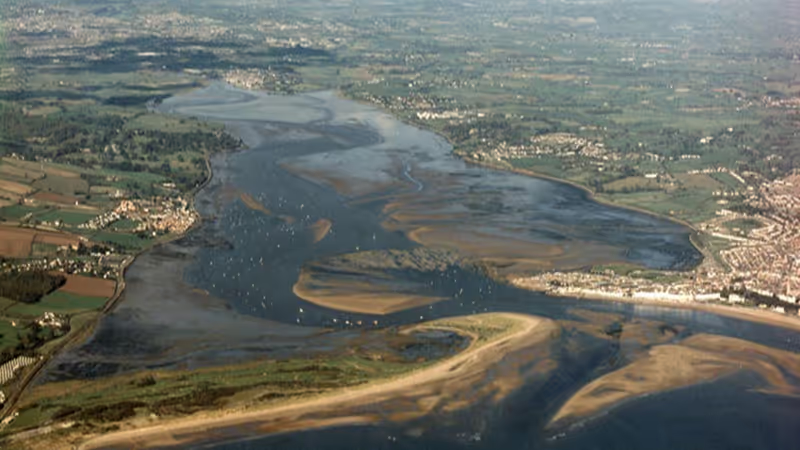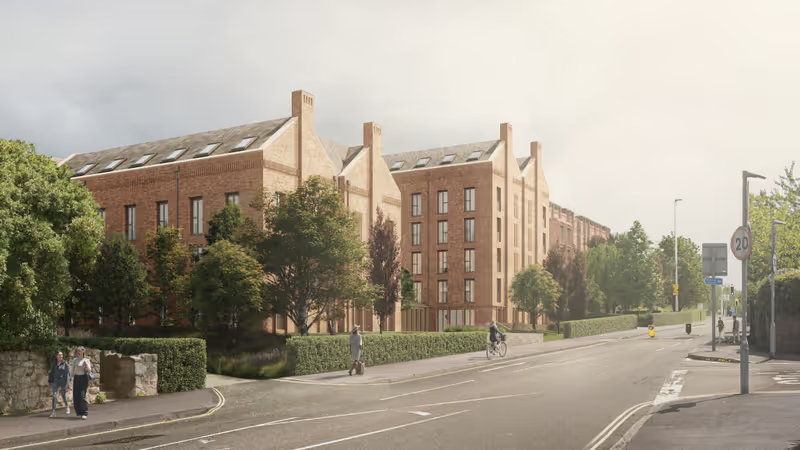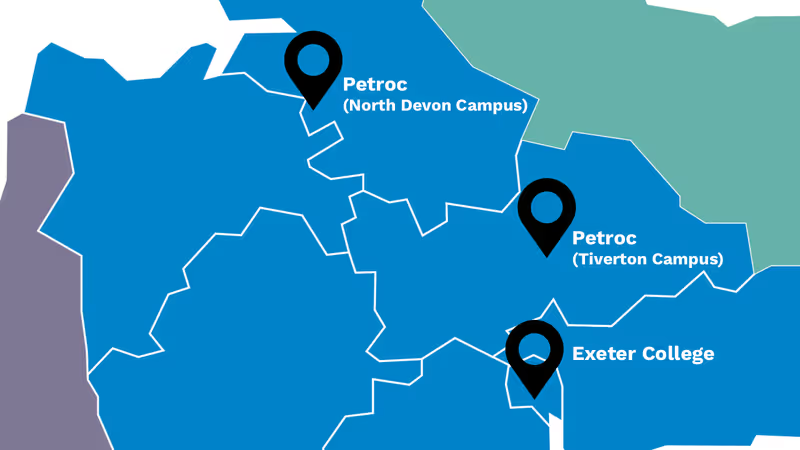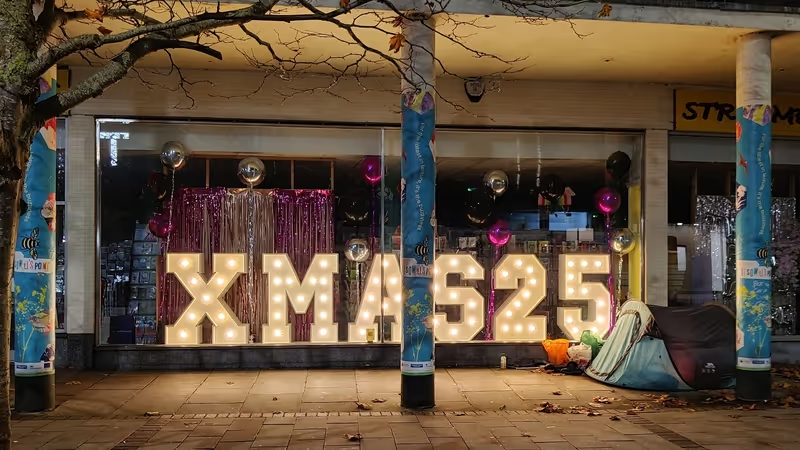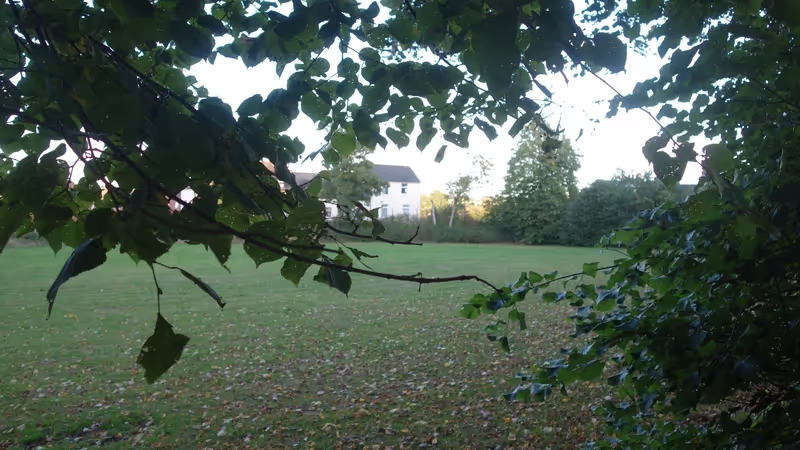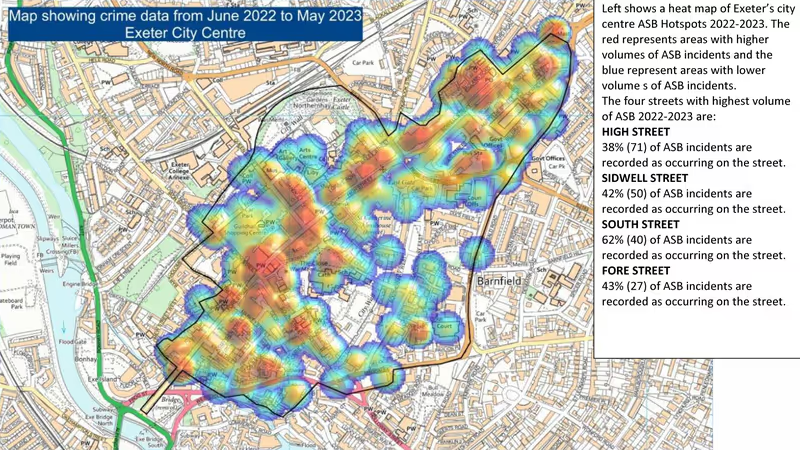Exeter City Council has disregarded national planning policy and Environment Agency criticism to approve plans for an industrial heat plant in Grace Road Fields, a fifteen acre ex-playing field beside Exeter Ship Canal which forms part of Riverside Valley Park.
Grace Road Fields is in flood zone three with a high probability of fluvial flooding from the River Exe, according to Environment Agency modelling.
Exeter Energy, a Leeds-based company controlled by 1Energy Group and Asper Investment Management, is to receive £42.5 million from the government Green Heat Network Fund to construct the plant, which is to use five 10MW gas boilers and a 10MW air source heat pump installation to generate heat for distribution to large institutional customers via a 13-mile underground network.
Exeter City Council, the University of Exeter, Royal Devon NHS Trust and Exeter College have been collaborating with 1Energy and Global City Futures, the company behind the defunct Exeter City Futures and its failed Net Zero Exeter 2030 plan, on the project for three years.
The privately-run commercial network, which is also expected to require between £55 million and £75 million in private investment, has been in the pipeline since the Department for Energy Security and Net Zero announced the Green Heat Network Fund in 2022.
 July 2024 Exeter Energy exhibition River Exe display board. Source: Exeter Energy.
July 2024 Exeter Energy exhibition River Exe display board. Source: Exeter Energy.
Exeter Energy’s plans have changed significantly since the government funding was awarded in January last year. When the heat network was announced, the government, the council and the government’s funding scheme partner all said it would use “the UK’s largest high-temperature water source heat pump”.
An unpublished report to last July’s Exeter City Council executive meeting also confirmed that the funding had been awarded “to provide a green heating network utilising water source heat pumps drawing water and heat from the River Exe” and a public exhibition launched by the company two days later repeatedly promoted the River Exe as the key to the scheme.
The July exhibition also said that the plant’s developer “intended” to rely on other heat sources such as air source heat pumps, an on-site data centre and “in the future potentially using waste heat from other nearby industries”, referring to the adjacent Marsh Barton waste incinerator, Exeter’s largest single source of carbon emissions.
“Back-up” gas boilers were also mentioned, as was the council’s nearby 1.2MW photovoltaic array in Water Lane despite it only being capable, in optimal conditions, of producing a fraction of the plant’s electricity needs.
Then, in December, Exeter Energy submitted an initial application to the council for outline planning permission to construct the plant. The Design and Access Statement included in the application documents didn’t mention the River Exe. Instead it said: “The primary source of heat generation will be from the air source heat pumps”.
In February the company confirmed it intended to rely solely on air source heat pumps, alongside gas boilers, in the first phase of the project, which it said would be complete by 2030.
It said that the project’s second phase would run from 2030 to 2035, when a “significant waste heat source” would be “available” from the adjacent Marsh Barton incinerator, adding: “We believe a connection is possible in 2030, subject to agreeing the contract and the construction timetable”.
It also mentioned the possibility of extracting waste heat from an on-site data centre sometime before 2035 but could not, when asked, provide examples of data centres elsewhere in the UK that are located in flood zone three. It said it did not have “the necessary information” to do so.
The company said the third phase of the project would begin in 2036 when it might consider other potential energy sources for the heat plant, if the heat network grew, including electric and hydrogen boilers, geothermal and solar thermal technology – and a water source heat pump.
A Green Heat Network Fund spokesperson subsequently confirmed that the government grant was “not conditional on the inclusion of a River Exeter water source heat pump” and that the project had been awarded funding for its initial air source heat pump phase alone.
The spokesperson also confirmed that the prospective use of waste heat from Marsh Barton incinerator and an on-site data centre, also repeatedly promoted by Exeter Energy, were only “potential” connections that might take place in later project development phases.
 Exeter Energy heat plant indicative render north elevation. Source: Exeter City Council.
Exeter Energy heat plant indicative render north elevation. Source: Exeter City Council.
In May, Exeter Energy significantly revised its planning application, replacing nearly fifty of the application’s accompanying documents.
The revisions included a redesigned principal plant building that was now just short of 400 feet long and 70 feet tall (the height of a typical seven or eight storey building) which had been raised six feet off the ground to reduce the impact of floods. Back-up diesel generators were also included to provide the plant with electricity during power cuts.
None of the previously-pitched data centre, water source heat pump or Water Lane solar array power supply were included in the application, and an incinerator connection was still only presented as a possibility. However detail on the proposed gas boilers was, for the first time, provided in an accompanying report.
It said there would be five of these, each providing 10.426MWth for a “total net thermal input capacity of the site of 52.13 MWth”. No more than four would operate at one time, with one serving as a backup, alongside a total of 10MWth provided by air source heat pumps.
The report added: “In the first few years of operation, it is expected that electrical power to the energy centre will be restricted due to a lack of upstream capacity. This will limit the operational capacity of the ASHP [Air Source Heat Pump] and therefore the boilers will be used for a higher proportion of the heating demand in this time.”
Never mind that electricity grid constraints in Exeter have already stopped several decarbonisation projects in their tracks, or that the government’s current target to clean up the electricity supply mix still only aims at 95% fossil fuel-free sources by 2030. Exeter Energy still calls its heat network “low-to-zero carbon”.
The company also makes much of its claim that it will save “over 13,000 tonnes of carbon emissions a year”, even though it admits that the plant is only “anticipated to achieve an annual reduction of 13,000 metric tons of CO2 emissions at full build-out of the base-case scenario” – which it doesn’t expect until 2035.
It doesn’t acknowledge that 13,000tCO2e is only around 1% of Exeter’s estimated carbon footprint, or that the adjacent incinerator is alone largely responsible for the annual 33,500tCO2e of greenhouse gas emissions produced by the city burning waste that would otherwise go to landfill.
Other claims it makes for the benefits of the project are missing essential context, too. Apart from variations in the total project cost, which it says will be worth “£100m+” in one place, “£110m” in another and “£120m” in a third, it presents this money as an “investment into the city” even though it also says that only around 70% of the total will be spent across the South West region and only “£1.7m of work is committed to businesses in Exeter”.
And while its claim that 90 people will be employed during plant construction and another 60 in installing the distribution network could be true, it also says that the project will create only four “new high-quality technical jobs” to run the plant once the network has been built.
Similarly, while it says it might support as many as ten local apprenticeships, it also says it might end up only supporting four.
It doesn’t present any more evidence to support any of these claims than it does for the “£3 million per annum of social value benefits” that it says the project will bring Exeter, or for its statement that the heat network “offers customers the lowest-cost way to decarbonise heat compared to alternatives such as individual building-level ASHP”.
The company also doesn’t seem to grasp that its claim that a possible future incinerator connection could be part of a “carbon neutral” heat network is not only inconsistent with reality – energy generated by combustion is the world’s principal source of greenhouse gas emissions – it is also inconsistent with government policy. All forms of energy from waste are to be excluded by the government’s Clean Power 2030 Action Plan.
Nor does it acknowledge that the incinerator contract expires in 2044, after which the facility will become redundant because its colossal emissions are incompatible with a low carbon future.
 Liveable Exeter Vision for a Transformational Housing Delivery Programme Water Lane redevelopment layout map, February 2019
Liveable Exeter Vision for a Transformational Housing Delivery Programme Water Lane redevelopment layout map, February 2019
The Exeter Energy project nevertheless does have one real advantage: that the council has bent over backwards to accommodate a heat plant in Riverside Valley Park by changing local planning policy to suit.
Grace Road Fields is designated as a recreation ground in the Riverside & Ludwell Valley Parks Masterplan, a supplementary planning document that forms part of the local development framework under the current Exeter Local Plan.
It was adopted nine years ago, but the council said as recently as 2021 that it was needed because of the impact of Exeter’s growing population on the Exe Estuary, which must be mitigated by law.
It said: “One of the elements of the mitigation strategy is the enhancement of alternative natural green space, and the council has identified these two parks for this purpose,” adding that the valley parks masterplan “sets out where new areas of public recreational space can be created, and where improvements to existing space can be made.”
Three years after agreeing the masterplan, the council adopted its “Liveable Exeter Vision for a Transformational Housing Delivery Programme”.
The accompanying strategic document identified several development sites, among which was the development site in Water Lane. It showed this as an extension of the existing Water Lane regeneration area further north towards Haven Road – but not further south to Grace Road Fields.
However, in July last year, the council’s executive committee decided that it should adopt a new Water Lane Supplementary Planning Document which has since been a material consideration in the determination of planning applications.
It extended the Water Lane development site to include Grace Road Fields, adding a policy setting out its potential uses. This begins by saying that any proposals for Grace Road Fields “should be developed in collaboration with the council and other stakeholders including Sport England to ensure a comprehensive strategy for the future use of the site”.
It also says proposals should prioritise enhancing nature and biodiversity, establishing the area as a “regional destination for recreation and water-related activities” and improving recreational opportunities, access to the canal and walking and cycling connections between Marsh Barton, the station and the valley park.
But despite its emphasis on the wildlife and nature importance of Grace Road Fields, the new policy slipped in that Grace Road Fields would also be an “energy opportunity site”.
Until recently, the council listed the Riverside and Ludwell Valley Parks Masterplan alongside the other SPDs which amplify the policies in the current Exeter Local Plan.
However it removed the masterplan and its accompanying explanatory statement from this list in May – the week after Exeter Energy submitted the final version of its outline planning application for Grace Road Fields – and replaced it with a different description that downgrades it to providing no more than a “vision”.
 Water Lane Supplementary Planning Document regulating plan, July 2024
Water Lane Supplementary Planning Document regulating plan, July 2024
Fiddling with local planning policy to support industrial development in the supposedly-protected Riverside Valley Park is one thing, even though it hardly reflects the environmental leadership claims in which the council likes to indulge.
Disregarding national planning policy guidance, which has the same legal status as the National Planning Policy Framework in planning decision-making, is another.
The sequential approach to the location of development laid out in this guidance says it is “designed to ensure that areas at little or no risk of flooding from any source are developed in preference to areas at higher risk” which means “avoiding, so far as possible, development in current and future medium and high flood risk areas”.
It adds: “Even where a flood risk assessment shows the development can be made safe throughout its lifetime without increasing risk elsewhere, the sequential test still needs to be satisfied”.
How does the sequential test work? The guidance says: “Where it is not possible to locate development in low-risk areas, the sequential test should go on to compare reasonably available sites within medium risk areas; and then, only where there are no reasonably available sites in low and medium risk areas, within high-risk areas.”
It says that “reasonably available sites” are those “in a suitable location for the type of development with a reasonable prospect that the site is available to be developed at the point in time envisaged for the development”.
It adds that these “could include a series of smaller sites and/or part of a larger site if these would be capable of accommodating the proposed development”, and that “such lower-risk sites do not need to be owned by the applicant to be considered ‘reasonably available’”.
The local planning authority, in this case Exeter City Council, is responsible for ensuring the sequential test has been properly followed in determining applications for development.
 Exeter Energy heat plant site flood zone location. Source: Exeter Energy Centre flood risk assessment.
Exeter Energy heat plant site flood zone location. Source: Exeter Energy Centre flood risk assessment.
Does Exeter Energy’s heat plant planning application pass this test? The company said last year that it chose Grace Road Fields for the plant after assessing thirteen other sites because Grace Road Fields is beside “a number of potential sources of low-carbon energy”.
It also said it chose Grace Road Fields, despite its position far from most of its proposed heat network customers, because the location “allows a practical route to connect the energy centre to the city”.
In May Exeter Energy said Grace Road Fields had been “carefully selected to maximise technical, environmental and economic viability” after an assessment of “multiple potential energy centre sites across the city” because of its location “close to key customers and low-carbon heat sources”.
It also provided a consultant-produced sequential test planning note as part of its revised planning application, which said it was intended to “inform discussions regarding the sequential test for an energy centre at Marsh Barton”.
The note leads by asking what might constitute “reasonably available sites” for the plant.
It cites national planning policy sequential test guidance that “the area to apply the test will be defined by local circumstances relating to the catchment area for the type of development proposed” which continues: “For some developments this may be clear, for example, the catchment area for a school. In other cases, it may be identified from other plan policies.”
It then says that Grace Road Fields has been “identified” as “suitable for an energy centre” in the Water Lane SPD, and that it is “also part of a wider site allocation within the emerging Exeter Local Plan for mixed use development and indicated as a potential heat network zone”.
Apart from the as-yet unadopted draft of the new Exeter Local Plan having little weight in planning decision-making, Grace Road Fields is not included in the areas which are the target of the new plan’s local energy network strategic policy CC3.
And while Grace Road Fields is – bizarrely – included in the draft of the new local plan as mixed use brownfield development site allocation SBA1, this policy only requires an energy strategy for the wider development site and is silent on the construction of new industrial infrastructure in the valley park – although it does have much to say about enhancement of the natural environment there.
The Water Lane SPD is similarly non-committal on an energy strategy for the proposed brownfield development, although the approved but not yet consented outline planning permission for the Water Lane development site proper includes provisions for the development’s own air source heat pump-powered energy centre.
The sequential test planning note also includes a map of the proposed Exeter Energy heat network route. It shows the Water Lane development as part of its business plan “base case” despite the council’s Five Year Housing Land Supply Statement confirming that “there is no clear evidence of a realistic prospect that housing will begin on site within five years”.
 Exeter Energy proposed heat network route. Source: Exeter City Council.
Exeter Energy proposed heat network route. Source: Exeter City Council.
Notwithstanding its failure to establish that a “reasonably available sites” catchment area for the Grace Road Fields application sequential test should be limited to the area covered by the Water Lane SPD, or the new Exeter Local Plan Water Lane site allocation, the sequential test planning note continues with a simple assertion.
This is that “the catchment area should be dictated by local circumstances and the requirements which can be attributed to air source heat pumps, water source heat pumps and connection to Energy from Waste building” – the Marsh Barton incinerator.
There is nothing in national planning policy guidance or Exeter Local Plan policy to support the claim that sequential test catchment areas should be dictated by water source heat pump or energy from waste connection requirements, or any other local circumstances which are not part of the planning application to which the test is being applied.
The note then says that Exeter Energy only considered five possible sites in its sequential test.
Apparently unwilling to insist that the catchment area for a heat plant serving a 13-mile energy network spanning half of Exeter should be restricted to a handful of sites within a stone’s throw of Grace Road Fields, the note adds that an assessment of fifteen “other locations around the city” has also been performed “in the interests of thoroughness”.
Only four of the twenty possible plant locations that the assessment then considers are in Marsh Barton. All are summarily dismissed as too small.
The other sixteen locations are assessed as if the Exeter Energy planning application does include connections to a River Exe water source heat pump and Marsh Barton incinerator, thus enabling the instant rejection of almost all of them on the grounds they are too far from either one or both.
The rest are similarly dismissed in an exercise characterised by unevidenced assertions and an absence of comparative analysis, in particular of flood risk.
What is even more remarkable about this assessment is that none of the potential energy centre sites identified by the Department for Energy Security and Net Zero in its Exeter Heat Network Zoning report are included in the assessment, even though the report confirms that its authors were in close contact with Exeter Energy about the company’s plans during its production.
In this report, one of 28 similar studies of places across the country, the government identifies five strategic heat network zones in Exeter using its standardised methodology. One covers Sowton, another the proposed new town in East Devon between the A30 and A3052 south of Exeter Airport.
The other three networks cover Wonford, the city centre and the university. The study identifies suitable brownfield land on which to locate air source heat pump-powered heat plants for each network: on the hospital estate, on the council-owned Magdalen Road car park and on the university’s Streatham campus. None of these locations are at risk of flooding.
It goes on to say that it identified the three strategic heat network zones separately as they “did not meet a sufficient level of linear heat density when combined”, but adds that “more localised detailed design work has proved that it is possible to combine the areas into a single larger network”, which is the proposal being pursued by Exeter Energy Network, spanning all three.
 Grace Road Fields in March
Grace Road Fields in March
There is no explanation for the absence of these potential heat plant sites in the application’s sequential test planning note, nor of why a distributed network with heat pumps on all three sites would not be a more efficient and resilient design which would avoid harming Riverside Valley Park.
Instead, Exeter Energy’s planning consultants cite a High Court judgement which they say clarifies the importance of “flexibility” in applying the test “even if it is considered that the sequential test is failed”.
In citing this judgement, apparently as an insurance policy against the risk the application does fail their sequential test, they don’t explain in what way such “flexibility” might be of relevance.
In it, the judge examines the interpretation and application of the sequential test. He says: “The policy to steer new development to areas with the lowest risk of flooding would be defeated if any examination of alternative sites is restricted by inflexible requirements set by developers.
“But a broad, non-specific approach by planning authorities to sequential assessments which generally disregards development requirements could lead to inappropriate business decisions being imposed on developers or the market. There is a need for realism and flexibility on all sides.”
He also cites a Supreme Court judgement that national planning policy guidance seeks to address this “inbuilt difficulty” in the sequential test by advising that developers have regard to the particular contextual circumstances when preparing their proposals “as regards the format, design and scale of the development”.
It continues: “As part of such an approach, they are expected to consider the scope for accommodating the proposed development in a different built form, and where appropriate adjusting or sub-dividing large proposals, in order that their scale may fit better with existing development.”
Neither judgement says that planning authorities should allow developers to ignore potential alternative heat plant sites that have been identified in government studies, or any others that might enable the proposed development in sub-divided form to address flood risk.
Nor, of course, do they say planning authorities should base their decisions on anything other than the information contained in each planning application and any material considerations that pertain, per national planning policy guidance on decision-making.
Nor do they say that developers who make speculative future business development claims about their planning applications are not required to provide substantiating evidence as part of those applications which demonstrates the credibility of those claims and the degree of certainty that they might one day be delivered.
The “flexibility” that is necessary to avoid the “inbuilt difficulty” in the sequential test does not mean planning authorities should simply ignore reasonably available alternative sites of which all involved are aware, or ignore the scope for delivering the proposed development across several sites to remove flood risk, or make decisions based on unsubstantiated claims about future business development plans that are not part of planning applications without any evidence to support them.
On the contrary, a range of High Court, Court of Appeal and Supreme Court judgements confirm the importance of realistic and rational assessment of proposed development in planning decision-making that should be based on transparent, proper reasoning and clear evidence that is relevant and up-to-date, including when it comes to speculative future claims about that development.
When Exeter Energy’s planning consultants say building a heat plant “close to the river and the energy recovery facility building” presents an “opportunity for connection along with the opportunity to use water source heat pumps and connection to the River Exe at a later date” they are correct.
But Exeter Energy’s planning application does not include any evidence that these speculative future connections will ever be delivered, so it should not be decided by relying on them any more than a local planning authority should accept a sequential test which ignores reasonably available alternative development sites that are not at flood risk at all.
 Exeter Energy heat plant site masterplan. Source: Exeter City Council.
Exeter Energy heat plant site masterplan. Source: Exeter City Council.
The Environment Agency is certainly not convinced. Its objection to Exeter Energy’s initial plans didn’t just point out that they are expected to pass the sequential test, it also added, drily: “We highlight that the submitted application is for an ‘air source’ heat exchange, while the sequential test document refers to a ‘water source’ heat exchange”.
Referring to national flood risk vulnerability classification definitions, it also questioned whether an air source heat pump-powered plant constitutes “essential utility infrastructure which has to be located in a flood risk area for operational reasons”.
It then repeated this criticism in its subsequent response to Exeter Energy’s revised plans.
It also commented that the length of modelled flood events in and around Grace Road Fields presents “significant risk to the continued operation of the energy centre”, adding that the provided flood risk assessment “lacks critical operational details” accounting for the viability of the heat plant’s proposed emergency back-up generators in prolonged flood conditions.
But it was most unequivocal about the sequential test planning note submitted with the application. It said it “includes references to the potential future water source/heat source options that are not part of the current application. We consider that these references, while noted, are not relevant to the assessment of this application and should not influence the sequential test conclusions”.
It continued: “We consider that the sequential test does not clearly or comprehensively present all the flood risks associated with the alternative sites. In particular, it lacks detail on surface water flood risks, which is a critical consideration. The assessment should go beyond a basic comparison of flood zone classifications and, instead, utilise the best available flood risk data, including Strategic Flood Risk Assessment outputs where applicable.”
It concluded: “We recommend that the sequential test should be revised to include a more detailed and transparent comparison of flood risks across all considered sites, incorporating surface water flood risk and Strategic Flood Risk Assessment data. This will ensure a robust and policy-compliant assessment in line with the requirements of the National Planning Policy Framework.”
But the submitted sequential test was not revised to address these or any other of its failings. And the report produced by the council for the August planning committee meeting that decided the application has almost nothing to say about the sequential test at all
While it begins by summarising national planning policy guidance on development decision-making in flood risk areas, it ignores the Environment Agency’s criticism of the submitted sequential test. Instead of interrogating this test to ensure it passes muster, thus discharging the council’s duty as local planning authority to uphold national planning policy, it simply gives it a free pass.
It then largely devotes itself to the scheme’s claimed benefits and whether they meet the requirements of the national planning policy exception test instead.
This test provides criteria to assess whether development proposals should be permitted in situations where no reasonably available sites at lower risk of flooding have been identified in a preceding sequential test. It should only be applied (following national flood risk vulnerability classification) when local and national planning policy provides clear reasons not to site the proposed development in any alternative locations identified as preferable by that sequential test.
To pass the exception test, if the sequential test has already been met, applicants must demonstrate that the development they propose will be safe for its lifetime in flood risk terms without increasing flood risk elsewhere, and that it will provide wider sustainability benefits which outweigh the risk.
Applicants must also provide local planning authorities with “relevant and proportionate evidence” to “demonstrate how both elements of the exception test will be satisfied”, using the objectives established in each area’s local plan sustainability appraisal to show that specific sustainability benefits outweigh the site-specific flood risk. If they do not, planning permission should be refused.
Exeter City Council sustainability appraisal objectives
- To ensure everybody has the opportunity of a decent home.
- To ensure that all groups of the population have access to the services that they require, in terms of the number of facilities and being able to reach them.
- To provide for education, skills and lifelong learning to: a) meet the needs of the local population, and b) meet local employment needs.
- To improve the population’s health.
- To reduce crime and fear of crime.
- To reduce noise levels.
- To maintain and improve cultural, social and leisure provision.
- To maintain and enhance built and historic assets.
- To promote the conservation and wise use of land and protect and enhance the landscape character of the city.
- To maintain the local amenity, quality and character of the local environment.
- To conserve and enhance the biodiversity of the city.
- To reduce the level in growth of car usage.
- To maintain a high quality environment in terms of air, soil and water quality.
- To contribute towards a reduction in local emissions of greenhouse gases.
- To ensure that there is no increase in the risk of flooding.
- To ensure energy consumption is as efficient as possible.
- To promote wise use of waste resources whilst reducing waste production and disposal.
- To maintain sustainable growth of employment for the city, to match levels of jobs with the economically active workforce.
- To maintain and enhance the vitality and viability of the city centre.
- To encourage and accommodate both indigenous and inward investment.
Source: Exeter City Council Core Strategy Sustainability Appraisal Non Technical Summary.
The council planning committee report says that the Environment Agency does not object to the proposed development on flood risk grounds, passing over the critical operational risks identified in its response. It simply concludes that this half of the exception test is satisfied on the grounds that the development would be safe for its lifetime (50-100 years according to Exeter Energy) in flood risk terms without increasing flood risk elsewhere.
It then considers whether the other half of the exception test is also satisfied: that the development would provide wider sustainability benefits that outweigh the residual flood risk.
It takes these to be “facilitation of a heat supply to a proposed district heating network” providing a “route to zero carbon heat” and “improvements to air quality”, the “provision of education and economic benefits” and the “enhancement of retained open space for recreation and biodiversity”.
The report nearly manages to avoid repeating Exeter Energy’s headline emissions reduction claim, for which the application provides no evidence.
It nevertheless admits that the “carbon savings of 13,000 tonnes annually” are only “estimated by the applicant” as a end-result of “supplying heat to networked sites including the Wonford and Heavitree Road hospital sites, Exeter College, the university’s Streatham and St Luke’s campuses, the Water Lane regeneration area and other sites located along the connecting network corridors”.
Of course, neither the distribution network nor any prospective supply agreements nor studies demonstrating that the network would yield greater emissions reductions than each of its large, institutional prospective customers installing their own facilities or participating in more localised, distributed heat networks is included in the application.
Nor does the report compare the heat plant dependence on gas boilers or the possibility of a connection to the high-emissions waste heat from the adjacent incinerator in five years’ time with the prospect of one or more of these institutions installing its own genuinely low carbon heating systems now.
Instead, the council apparently simply assumes that a single, citywide network would be both more resilient and more likely to reduce emissions both now and in the future, when it apparently believes that the network will become truly zero carbon even though there is no date for this in sight.
The report does say that planning consent for the plant could be conditional on the provision of a “carbon reduction plan” to ensure that the “promoted carbon benefits of the development are realised”, that it complies with “legislative targets and local objectives” and it “monitors emissions related to the heat supply”. But no such plan is included with the application, nor any of the parameters it might contain.
A graph provided by Exeter Energy, after the council report was written, purports to address the lack of evidence included in the application in support of the company’s emissions claims. But all it shows is the division of its projected annual heat demand into two segments.
It does not quantify the plant’s expected emissions, or compare them with the existing heating-related emissions of the network’s prospective customers, or explain why the plant requires five times as much generation capacity from gas boilers as it does air source heat pumps, or how electricity supply grid limitations, which will prevent it using air source heat pump capacity for several years, will affect its reliance on gas.
Nor is the graph dated. Does it represent heat demand during the plant’s first year of operation or its tenth year, when it reaches “full build-out of the base-case scenario”?
 Exeter Energy heat demand distribution graph. Source: Exeter City Council.
Exeter Energy heat demand distribution graph. Source: Exeter City Council.
It is just as unclear how the council planning committee report has derived the conclusion that the heat plant will “enable improvements in air quality impacts in other parts of the city through reduced combustion at sites supplied by heat from this development”. The submitted air quality assessment only covers the development site itself and has nothing to say about air quality elsewhere.
And it’s the same story with the claimed creation of Exeter College apprenticeships and “over 150 jobs during construction”. Exeter Energy has apparently “advised” the council that this will happen and the council seems to have accepted this advice at face value, without any supporting evidence.
(The company’s claim that four permanent jobs will be created is missing from the report altogether, as are its claims about local investment.)
When it comes to the impact of constructing the heat plant in a Riverside Valley Park green space, the council report cannot avoid acknowledging “tensions between development plan policies which seek to protect the open space and landscape setting of the city and those which promote some development in the area of this site”.
It says the Water Lane SPD identifies the site as part of an area for open space uses but also green energy opportunities, so Exeter Energy’s planning application is “considered to accord with the principles of the SPD”.
But it also admits that the Riverside & Ludwell Valley Parks Masterplan, while “not endorsed for development management purposes”, does carry some – albeit limited – weight in local planning decision-making, and that Exeter Local Plan policy EN6 only supports renewable energy facilities “provided that the benefits outweigh harms, including to landscape”.
Grace Road Fields is only a mile from the Exe Estuary, which is a Site of Special Scientific Interest, a Special Protection Area and a Ramsar site.
But the report finds that the plant will not have “a significant effect on those sensitive sites” even though it will remove several acres of valley park green space immediately alongside the 4,000 or so additional residents who are eventually expected in Water Lane – with another 4,000 subsequently due in the housing that will replace much of the adjacent section of Marsh Barton industrial estate.
It also finds that, although Grace Road Fields is inside the 10km Special Protection Area buffer zone, where housing and tourism development must be mitigated, the heat plant is not “expected to result in increased recreational pressure upon the site” because it is neither of these.
Grace Road Fields is also a Site of Nature Conservation Interest, with a range of species – including protected species – recorded there. Exeter Local Plan policy LS4 is intended to protect such sites, but allows “appropriate compensatory measures” to mitigate identified impacts.
At Grace Road Fields species translocation and a lighting strategy, to be combined with a bat buffer, are “considered sufficient for the proposed development” in this respect.
Overall, while the report finds that “there will be some impact on the area as a result of this development” it concludes that it “would not be of a scale and nature likely to result in significant environmental effects”.
It also finds that a proposed Biodiversity Net Gain uplift and “further enhancement of the wider field” – according to purely illustrative “concept designs” submitted in support of the application but not as part of it – are sufficient to satisfy any remaining concerns.
Despite the applicant demonstrating none of the scheme’s claimed benefits, which would be of doubtful significance even if delivered, the report concludes: “None of the adverse impacts, individually or cumulatively, are considered to significantly and demonstrably outweigh the public benefits of the development when assessed against the policies in the National Planning Policy Framework or the local development plan when taken as a whole”.
The proposals are therefore “considered to constitute sustainable development overall” for which planning permission should be approved.
 Council leader Phil Bialyk announces he is reviewing the decision to sell the green space behind Clifton Hill sports centre for development in July 2019. Source: Exeter Labour.
Council leader Phil Bialyk announces he is reviewing the decision to sell the green space behind Clifton Hill sports centre for development in July 2019. Source: Exeter Labour.
Like the Environment Agency, other consultees are not convinced. Sport England says it “cannot currently support the application in its present form” because it does not accord with its Playing Fields Policy or the National Planning Policy Framework.
Devon Wildlife Trust objects on the grounds that the proposals “do not provide sufficient evidence to satisfy the requirements relating to biodiversity” in the National Planning Policy Framework and have not addressed the requirements of the Environment Act 2021.
Friends of Exeter Ship Canal says it is “fundamentally opposed” to the plans because they would “restrict viable and safe mooring, quays and maritime services on the canal which are necessary to replace future losses in the Exe Estuary as a result of the continuing loss of Dawlish Warren” and says the revised application’s heat source mix “nullifies the arguments for choosing this site over others”.
Exeter Civic Society says that “building such a facility within the Riverside Valley Park will result in the loss of a significant area of green infrastructure” which it considers “essential to support future residents of brownfield development sites in the wider Water Lane area” and adds that the sequential test is “completely flawed” and should be reviewed.
The objections of many local residents reflect similar concerns, adding accusations of “deliberate deception” in Exeter Energy’s “misleading” approach to public consultation and subsequent application.
One says the council “risks locking in carbon emissions for the next 70 years” in approving a “primarily gas-fired heat network”, adding: “A renewable heat network is a desirable facility, as is an unspoilt Riverside Valley Park long-protected by council policy documents and plans.
“The committee has to be sure that the sacrifice of the existing benefits of one will deliver the promised, but presently absent, benefits of the other.”
Another says Exeter Energy’s proposals are “simply the building of a factory on a greenfield site that has been previously marked for protection, when there are many more suitable locations”, adding that the change in heat sources could be “characterised as a complete falsification of those plans to justify the use of a greenfield site that is cheap and easy for them to develop”.
Diana Moore, city councillor for St David’s ward in which Grace Road Fields sit, submitted a seventeen-point objection to the plans which said they lacked quantified and time-bound emissions targets and failed to support the applicant’s “low carbon” claims, among other things.
In response, the applicant’s agent said that “additional cost to customers” that would reflect the “emissions reduction approach and time-frames” that they specified would mean the company “cannot commit to decarbonisation time-frames and milestones to the council, as the decision will ultimately rest with anchor load customers”.
The agent also said that while it is “theoretically possible to power the whole energy network with 100% low carbon technology” doing so would be “hugely expensive to install and run” and “not viable because the electricity grid in Exeter doesn’t have anywhere near enough capacity”.
A subsequent objection, responding to the agent in turn, asked whether one anchor load customer’s desire to be “satisfied with a small reduction in carbon” to save money would mean other network customers would have to accept the same, limited, carbon reductions too.
It also asked whether electricity grid supply limitations at Grace Road Fields could be resolved with a different network design which distributed generation capacity across several sites, as the government study had suggested, and asked how the heat plant site selection process, and by extension the sequential test, had not factored in the inadequacy of the supply at Grace Road Fields.
 Exeter Energy heat plant indicative render west elevation. Source: Exeter City Council.
Exeter Energy heat plant indicative render west elevation. Source: Exeter City Council.
There were no answers to any of these questions when the council planning committee met last week to consider Exeter Energy’s application.
Deliberations began with Exeter Civic Society chair Keith Lewis reminding the committee that Riverside Valley Park is public open space but that Exeter Energy’s proposals would “occupy half of Grace Road Field and blight the other half with noise pollution and views of this huge industrial building”.
He added that the many other uses identified for the field in the Water Lane SPD are now unlikely, pointed out that the heat plant’s dependency on gas boilers would be exacerbated by an insufficient electricity supply and highlighted sequential test flaws.
He then urged the committee to defer its decision so the applicant could provide a detailed carbon descent plan for the facility, including defined mandatory carbon emissions reductions dates and reporting mechanisms, and confirmation of the date by which the electricity supply would be sufficient to power the proposed air source heat pumps.
He also urged it to insist on a revised sequential test report which addressed the Environment Agency’s criticisms.
Committee members ignored his recommendations. Yvonne Atkinson even insisted that the civic society should itself be responsible for finding an alternative site for the plant.
Paul Barker, representing Exeter Energy, then reeled off a series of claims about the purported benefits of the proposed network. Most were future-focussed, concerned matters outside the scope of the application or were not supported by application document evidence.
Committee chair Paul Knott, who normally never tires of reminding committee members that its decisions can only be based on the information contained within the applications in front of them, and any material considerations that pertain, did not react.
When committee member Rob Harding asked Paul Barker about the prospects for the company’s claimed future incinerator and water source connections, the response was that Exeter Energy couldn’t predict future demand but it was “95% confident” about an incinerator connection in the next three years and that a water source connection could happen “at some point in the future”.
Committee member Michael Mitchell then asked whether Grace Road Fields really was the only possible location for the heat plant in the whole city. Paul Barker answered that it was the only one beside the incinerator and near the river.
He then asked how many years of highways disruption the network installation would cause. Paul Barker tried to evade the question then was rescued by Paul Knott, who said it was future-focussed and had nothing to do with the application in front of the committee.
Committee member Andy Ketchin raised the sequential test and asked whether Exeter Energy had approached any Marsh Barton landowners to discuss the possibility of acquiring a brownfield site there for the plant.
Paul Barker said it had not, adding that the company’s agent had only looked at what was being advertised for sale before saying it had discounted Marsh Barton as it was on the wrong side of the railway line to connect to the river or canal in any case.
Andy Ketchin then asked how much time the council had spent checking whether the claims made in the submitted sequential test were true, and whether it had looked at possible alternative sites for the plant in Marsh Barton. The council owns 65 freeholds on the trading estate alone.
Council development director Ian Collinson responded that the question was unreasonable, unfair and that the council didn’t know the answer in any case.
Andy Ketchin raised the sequential test shortcomings again. He said no compelling reason for constructing the heat plant in Grace Road Fields had been presented and that, in particular, no justification had been provided for the claim that it would be impossible to build the plant on a brownfield site in Marsh Barton industrial estate.
He added that the evidence that had been provided with the application was flimsy, if there was substantive evidence to support the application it had not been provided and that the decision required real scrutiny of the sequential test.
Ian Collinson evidently disagreed. He said that that the plant would “strengthen Exeter’s role as a leader in sustainable development and climate action”, and added: “In actual fact, it’s very clear from the officer’s assessment and from the advice of the Environment Agency that it has passed the sequential test”.
All the committee members except Michael Mitchell and Andy Ketchin voted to approve the application. It was apparent that several believed that the Environment Agency was happy with the plans, while others had taken Exeter Energy’s future business development claims or other matters outside the scope of the application into account in deciding how to vote.
 Unpublished report to July 2024 city council executive meeting. Source: Exeter City Council.
Unpublished report to July 2024 city council executive meeting. Source: Exeter City Council.
Where does this decision leave the scheme? Exeter Energy still has to apply for approval of the reserved matters that were not part of its outline application, which only covered layout, access and scale.
As last week’s decision established that the council is happy to see the heat plant built in Grace Road Fields reserved matters approval is now more or less a formality.
The council, however, still has to follow through on selling the land in Grace Road Fields to Exeter Energy to enable the development.
While it decided in private in July last year to sell part of the field to the company in principle, immediately after adopting the Water Lane SPD at the same meeting to help pave the way, it is not allowed to proceed to a sale based on that decision alone.
As the unpublished executive report on the matter points out, because Grace Road Fields is part of the Riverside Valley Park the council is required by law to hold a public consultation on its disposal, and must “consider any objections to the proposed disposal which may be made” before re-affirming the decision to sell.
The council quietly opened a public consultation on the sale – not the parcel of land councillors had agreed to sell in July but a much larger plot – at the end of November. The scant consultation materials it provided failed to mention that Grace Road Fields is part of the Riverside Valley Park, and it didn’t promote the consultation until three weeks after it opened.
When the council approved the sale in principle, it nevertheless formally resolved that the public consultation results would be “presented to executive prior to any exchange on the disposal of the site”. Despite auditor criticism of its public consultation methods, including its failure to ensure “openness and comprehensive stakeholder engagement”, the council has yet to publish them.
It was due to re-affirm the disposal decision at an executive meeting in February. But the item did not appear on the agenda and it subsequently disappeared from the executive forward plan too.
It then reappeared as scheduled for the June executive meeting instead, but again did not appear on the agenda (the meeting was moved back to 20 May). It has yet to resurface, and the site red line boundary in the outline plans that have just been approved covers nine acres of land – three and half times as much as the 2.5 acre sale that was originally agreed.
 Exeter Energy heat distribution network works in Belle Isle Drive
Exeter Energy heat distribution network works in Belle Isle Drive
Meanwhile, the heat distribution network is being built out after works began at Belle Isle park five months ago, where the installation of a short section blocked access to Trews Weir bridge for four months. A resident said the excavations are “not typical street works” but “wide enough and deep enough to drive through”, like “digging a mini channel tunnel through sixteen miles of Exeter”.
The council executive was also supposed to see a report on the distribution network, framed as covering “the city council’s wider role in enabling the rollout”. It first appeared in the executive forward plan in April last year, and has been postponed eight times since, disappearing then reappearing then disappearing again. This report also has yet to resurface.
Works continue in Trews Weir Reach. In October Topsham Road will be blocked for the six weeks that routing the network from Trews Weir Reach into Matford Lane will apparently require. The rest of the network is expected to take around a decade to complete.
Devon County Council, which is responsible for approving the Temporary Traffic Regulation Orders required for such excavations, does not publish notice of these applications on its website or make them available via its active orders search.
It did not explain why it does not do so when asked, nor did it explain why the works orders also do not appear on the One Network traffic disruption monitoring platform until after they have been sealed.
What it did say, in response to Exeter Energy’s application to build the heat plant in Grace Road Fields, was this: “The laying of any pipework associated with this development could have an impact on all types of traffic (vehicular and non-motorised users) throughout the city and cause delays for all users of the highway network.
“When considering the size of Exeter city and the potential spread across the city of end users for the heat network, there could be a requirement for a substantial amount of traffic works throughout the city and these works could involve traffic management and or road closures to complete the work.
“While all these works would not be undertaken at the same time, there may be cases where there are multiple works to take place within the city at the same time, this will still represent a sustained level of roadworks throughout the city for a considerable time.”
It added: “Whilst this aspect of the planning application does sit outside of the red line of the planning application, it will likely cause there to be disruption within the city of Exeter.
“There is no information regarding scale of the pipe networks nor what routes this would take and no way to assess the impact at this time.”
